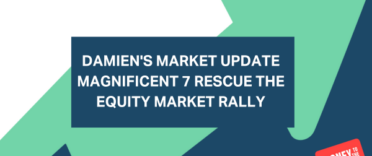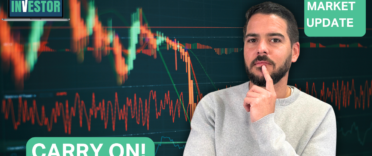Welcome to the latest episode of my monthly YouTube show where I discuss what is happening in investment markets and what to look out for. This month I explain the impact that raising interest rates has had on markets and how the UK Chancellor's mini-budget added more fuel to the fire.
Each show lasts between 5-10 minutes and is aimed at DIY investors (including novices) seeking contemporary analysis to help them understand how investment markets work.
Subscribe to my YouTube channel to receive my weekly analysis of investment markets or alternatively, you can listen via my weekly Midweek Markets podcast below.
Damien's Market Updates monthly podcast
Other ways to watch, listen and subscribe
You can listen to other episodes and subscribe to the show by searching 'Money to the Masses' on Spotify or by using the following links:
Abridged transcript - Damien's Market Update - October 2022
If investors thought August was bad for their portfolio then September was even worse and lived up to its billing as the worst month of the year for stock market returns.
Just to recap we entered September after bearish sentiment took hold of equity markets once again as the summer equity rally collapsed into nothing more than another bear market rally. Take the S&P 500 as an example, after rallying towards its 200 day moving average in August markets it collapsed in a heap and headed towards 3900 level a the start of September as investors realised they had mis-judged the supposed “Fed-pivot".
The weakest August performance for US stocks since 2015 was swiftly followed by the worst September since 2002. As I’ve mentioned, September is historically the weakest month of the year for most equity markets, and history suggested that the S&P 500 was likely to fall by around 1%. But instead the S&P 500 fell by an incredible 9% during September 2022. Ultimately it meant, as suggested in my last video, the index revisited its June low of 3666, but went on to set a new low for 2022 at 3,585 on 30th September. That took the S&P 500s year to date performance fall to more than 25%, well into bear market territory.
But the equity market carnage was not isolated to the US, far from it. During September the MSCI AC Asia ex Japan index fell over 10%, the MSCI EM index fell 9.5%, the MSCI AC was down 8.6%, the Nikkei 225 was down 7.6%, the DAX -5.61% and the FTSE 100 was the relative outperformer at -5.36%.
In last month’s video, I highlighted that the pound fell more than 4.5% against the dollar during August, the worst monthly performance since the Brexit referendum in 2016. This put the pound at a 37 year low against the US dollar - which actually was positive for my own 50k portfolio.
Not to be outdone, during September the pound crashed 8% to $1.038, which was an all-time low for the dollar/pound exchange rate. But this wasn’t a strong US dollar story, it was a UK economic crisis story which meant that the pound fell against pretty much every other currency you care to mention. The one positive was that it insulated the overseas assets within your portfolio from the worst of the market falls, by providing a much welcome currency boost.
Take the S&P 500 for example, taking account of the weakness in the pound it reduced September's 9% loss down to 5.4%. Still appalling but better than it could have been.
What caused September’s carnage? In the first half of the month much had to do with the US dollar index which hit a 20-year high last week. A strong dollar not only tends to hit US stocks but also commodities (especially gold) as well as proving a headwind for Asian and emerging markets. In contrast, a strong dollar versus the Japanese yen tends to be positive for the Nikkei 225, while a weaker pound versus the stronger US dollar can provide some support for the FTSE 100.
The US dollar index goes a long way to explaining many of the market moves we saw in early September but also throughout this year, especially since mid-June. But as the month went on other factors started to dominate. Firstly the second half of September is historically weaker than the first half of the month, and this seasonality once again held true this year.
Initially the catalyst was a number of central banks including the Bank of England (BOE) raising interest rates which immediately caused bond yields to explode higher around the globe while yield curves inverted (a sign of impending recession). Investors began betting that central banks' aggressive tightening of monetary policy, aimed at combating inflation, would have a lasting damaging impact on domestic economic growth. Ultimately forcing them to cut interest rates in 2024 to stimulate economic growth once again. This caused the yields on short dated government bonds to rise higher than those of longer-dated bonds - hence the inversion.
With bond and equity markets already starting to look like a burning wreckage, UK Chancellor, Kwasi Kwarteng, decided to make matters worse when he unveiled his, now infamous mini-budget. What was hailed as the biggest tax cut in 50 years, prompted markets to recoil in horror. The scale of the required government borrowing to deliver his plans sent shockwaves through gilt markets. Gilt yields saw their biggest one-day jump on record with the 5 year gilt yield breaking above 4.7% (having started the day around 3.5%), as concerns grew over how the UK government will finance its stimulus plans. The market’s vote of no confidence in the UK was also reflected in the value of the pound which plummeted ultimately to the all-time low against the US dollar mentioned earlier.
The jump in gilt yields (irrespective of the term) was phenomenal, because what would normally take years to occur, took place in a matter of days. The rise in gilt yields saw the UK mortgage market freeze with 40% of mortgage deals pulled in a matter of days. But perhaps even more worryingly was the impact on final salary pension schemes that came close to going bankrupt as the value of the gilts they held tumbled. While the BOE has an inflation mandate it also has another mandate which is to ensure financial stability, which includes making sure financial markets function in an orderly manner. The run on gilts ultimately threatened the UK pension system and forced the BOE to intervene in markets in a way not seen outside of the pandemic or the financial crisis. The BOE promised to buy up to £5billion of long dated gilts every day to prop up the gilt market and put a cap on gilt yields. We can debate about the definition but the BOE essentially started Quantitative Easing (QE) again while paradoxically raising interest rates at the same time. The former tends to fuel inflation while the latter quells it.
In a world where most central banks are racing to tighten monetary policy, the Bank of England has blinked first. It raises the question as to whether we are now seeing the start of central banks pivoting to more accommodative monetary policy. If it is then could that signal that the bottom of the market is in? After all when central banks intervened on 23rd March 2020 at the depths of the pandemic, it marked the start of the next bull market in stock.
As we enter October equity markets, fresh from their 2022 lows, have exploded higher. The S&P 500 has leapt more than 5% in the first two trading days of the month. The best start to a month on record, as investors bet the US Federal Reserve will now follow the BOE’s lead and pivot to more accommodative monetary policy. We saw similarly powerful moves right across global equity markets. But is this sustainable?
I don’t know but equity markets have been here before - trying to front-run a pivot by central banks and we know how that ended. That doesn’t mean this rally will but it’s better to be right than first. Which means why try and call the market bottom? You can still profit from it even if you miss the initial move. If seasonality continues to influence markets this year, then the good news is that we are entering a positive period for stocks. After the hurricane in markets during September, the relative calm over the last few days, isn’t yet proof the worst is over. We could still just be in the eye of the current storm.



